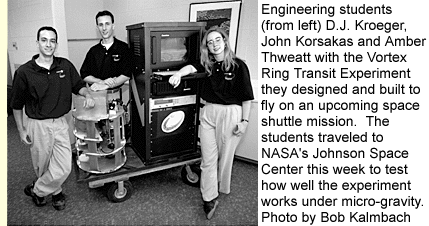The University Record, April 15, 1997
U-M engineering students to ‘float’ through NASA micro-gravity test flight
By Sally Pobojewski
News and Information Services
 Three U-M engineering undergraduates will get the ride of their lives this week when they experience near-weightless conditions in the same KC-135A research aircraft seen in the movie Apollo 13 and used to train NASA astronauts.
Three U-M engineering undergraduates will get the ride of their lives this week when they experience near-weightless conditions in the same KC-135A research aircraft seen in the movie Apollo 13 and used to train NASA astronauts.
The U-M team was one of 24 selected by NASA scientists to participate in the program, which is administered by the Texas Space Grant Consortium. Each student team designed an experiment to conduct during the 30 to 50 intervals of “zero-gravity,” each lasting about 25 seconds, that occur during the repetitive parabolic arcs flown by the aircraft during the three-hour flight.
U-M students participating in the program are:
Amber Thweatt, a senior in aerospace and mechanical engineering from South Haven.
Dennis J. Kroeger, a senior in aerospace engineering from Glen Ellyn, Ill.
John Korsakas, a senior in electrical engineering from West Bloomfield.
On April 7, the U-M students reported to Ellington Field, Texas, home of the Johnson Space Center’s Reduced-Gravity Program, for a week of pre-flight training and orientation. The team’s KC-135A flights were scheduled for April 14-15.
“The students undergo the same training program used to prepare NASA astronauts and have the same opportunity to get sick as the astronauts do,” said Sven Bilen, graduate student and team adviser, who compared the flight experience to Cedar Point’s “Demon Drop” repeated 30 times in succession. “There’s a reason why NASA calls the KC-135 the `vomit comet,'” he said during a Record interview before the team left for Texas.
“I’m sure I’ll scream during the first parabola, but it’s a great opportunity,” said Thweatt. “We all want to be astronauts and this is the closest we’ll ever get.”
The U-M team designed and built a Vortex Ring Transit Experiment to answer some basic questions about atomization—the same process that takes place in an automobile fuel-injection system to convert a liquid into small droplets suspended in the atmosphere. “It’s sort of like a lava lamp,” explained Kroeger. Under reduced gravity, the students will be able to generate and photograph larger droplets than can be produced on Earth. Data and images from the experiment will lead to increased understanding of just how the atomization process takes place.

